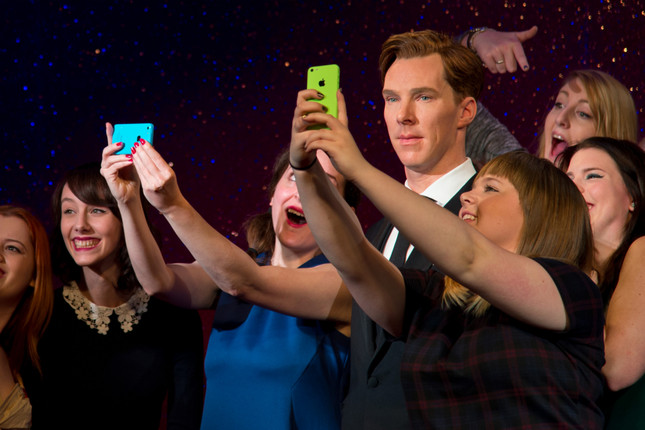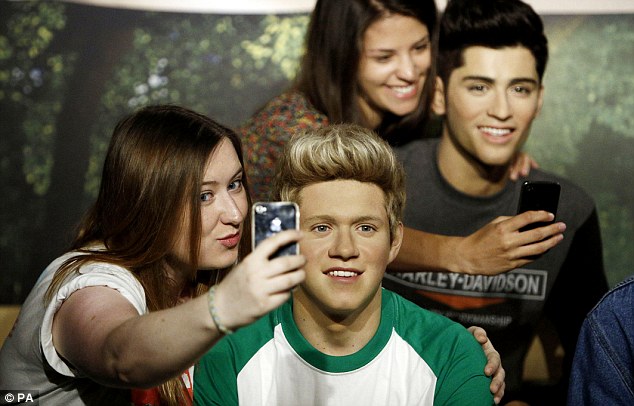Wax Museums Survive the Digital Age.
Maybe because you can’t put your arm around a retweet.
BY: DEVON MALONEY
On a recent weekday afternoon, in the dimly lit rooms of the Hollywood Wax Museum on Hollywood Boulevard, I saw, in no particular order: a girl wrap her arms around Elvis Presley, frozen with an acoustic guitar in mid-career form, a woman lounging in bed with a red-silk-robed Hugh Hefner, and a scrawny teenage boy pretending to twerk against a bizarrely inaccurate rendering of Beyoncé.
Each slightly abashed museum patron captured the moment via camera phone. It seemed strange at first, watching as they exercised this most Instagram era of impulses with the most analog of attractions. But it turns out their actions went a long way toward explaining how the celebrity wax museum still exists, and, arguably, flourishes as a business in 2015.
Scientists, artists, and those who fall somewhere in between have been obsessed with creating the perfect fake human for centuries. As early as the Middle Ages, wax figures representing deceased royals and clergymen were displayed to allow the living to pay their respects “in person” to the objects of their veneration.
Today, wax figures of Beyoncé and One Direction can appear so mortal that you might not have noticed they weren’t, if it wasn’t for their frozen-eyed stare. However such an archaic (not to mention a smidge macabre) conceit might be viewed in theory, the attractions are still a self-contained international industry, without having to change much since Marie Tussaud established her first museum on London’s Baker Street in 1835.
It’s Not a Museum.
“We’re not a wax museum, we’re a wax attraction,” says Petra van der Meer, U.S. figure maintenance manager (a fancy way of saying head artist) for Madame Tussauds, still the best-in-class purveyor of wax, ahem, attractions nearly two centuries after its founding.
These days, Tussauds’s parent company is Merlin Entertainments, the second-largest theme-attraction group in the world after Disney. Merlin acquired Madame Tussauds for $1.9 billion in 2007, about half a billion dollars more than its previous owners paid for it two years prior. According to Merlin’s 2013 earnings report, its “midway attractions,” which also include Legoland, saw a 12 percent increase in visitorship and a 14 percent increase in revenue, from 2012 to 2013.
I spoke with van der Meer in December, in the 32,000-square-foot exhibit hall of the company’s new San Francisco outpost. (The family-owned San Francisco Wax Museum that used to occupy the same space closed its doors on its 50th anniversary in 2013; it currently leases the building to Merlin and Tussauds.) She sat on a bench in a dimly lit, well air-conditioned hall between Jennifer Aniston, who had her back to us, and an adorable Betty White, posed and styled in a floor-length gown, as if she were walking the red carpet. Van der Meer, a 20-plus-year veteran artist of the wax-house world, was in town on her regular maintenance circuit around the company’s six American locations, about a third of the 19 it operates globally. It will open its 20th in Orlando this spring.
“Basically what we see in this room, there’s no ropes,” van der Meer says. “People can interact with the wax figures:
- you can stand close to them,
- you can take pictures,
- you can hug them
. . . . In a museum, you’ve got big signs [that say], ‘Don’t touch.’”
Ask those in the business the secret to their survival and they’ll invariably bring this up: after taking down the ropes that once separated wax figures from their admirers in the 1990s, the houses have become a tactile, interactive celebrity experience that counteracts our digital lives, in which @-replying Harry Styles a million times has the tendency to estrange one from the real world.
The Art of Resemblance
“What makes this so special is that we’re still using the same technique as Madame Tussaud did 250 years ago, the painting and everything,” says van der Meer, echoing a sentiment several staffers repeat multiple times over the course of our visit. “The reason we have such high-quality figures is that most of the figures that you will see in this room, we had sittings with.”
The “celebrity sitting” is the linchpin to which the chain attributes its success as a business in the modern era. A team of Tussauds artists will:
- Meet a celebrity wherever they are (the Dalai Lama had his at an airport)
- Measure meticulously for two hours
- Take color samples and more than 250 photos from as many angles as possible
As measurement-taking technology like digital photography and 3-D modeling has improved, so has the artists’ ability to make more accurate celebrity likenesses. Instead of being constructed on-site at any one location, these specifications are relayed to the company’s London headquarters—like Jim Henson’s Creature Shop, but for Lady Gagas and Morgan Freemans.
“These are fine-art sculptures, and we’re creating more art as we continue to grow, and as we bring new figures into the attraction, [we grow even more],” says Dalia Goldgor, the general manager of Madame Tussauds San Francisco.
LEARN MORE : Watch the wax figure making process below
The World’s Love For Wax Figures
But the success of the industry certainly does not hinge entirely on a painstaking, technologically advanced process. Celebrating its half-century mark this year, the family-owned Hollywood Wax Museum has four locations nationwide, two of which were opened in the last 10 years. (A much smaller, and quirkier outfit than Tussauds, Hollywood Wax declined to share its attendance numbers.)
Today, the museum displays roughly 180 figures at a time, rotating them regularly; most, if not all, seem to have been created freehand by in-house sculptors—which would explain the slightly inexact nature of sculptures like our aforementioned Beyoncé. Tej Sundher, co-owner and grandson of Spoony Singh, who founded Hollywood Wax in 1965, attributes its longevity to the public’s ever-growing fascination with fame.
“[The obsession with] celebrity, which was of interest when we opened and probably only growing since then,” Sundher says of his wax works, which occupy the end of the attraction spectrum opposite Tussauds’s sleek corporate-owned operation. While the press, including The New York Times, Los Angeles Times, and Vice, has occasionally praised Hollywood Wax’s Hollywood Boulevard flagship for its camp factor, Sundher maintains a mostly all-press-is-good-press attitude. Like the Magic Castle or costumed characters in Times Square or outside TCL Chinese Theatre, even low-budget wax museums seem to fill a need for more tangible entertainment.
“Technology actually makes the [wax museum] experience even better,” Sundher said. “For example, Facebook: the ability to snap a picture next to your favorite star and show the world that you did that, it extends our brand and our experience even more.”
So really, why are we still so into these weird, vacant-eyed, skin-colored beeswax statues that don’t move? It’s not just foreign tourists keeping these oddities afloat; both Tussauds and Hollywood Wax describe their visitor demographics as ranging from school field trips to foreign tour groups, to average American families. (Also, journalists.)
The better question might be, what makes us so obsessed with celebrities that we would happily pay $40 to take selfies with fake versions of them?
“There is an identification with famous people as a substitute for the obscurity of one’s own existence, so knowing somebody famous somehow can lead one to share in that fame, if not the money,” said Dr. Mathieu Deflem, a sociologist at the University of South Carolina.
LEARN MORE: Professor Goes Gaga: Teaching Lady Gaga and the Sociology of Fame
In other words, even seeing replicas in a museum “establishes a connection—‘I saw Prince William!’—that transcends space and time,” Deflem said.
You can ‘meet’ people from far away and long ago. So being at such a museum is a liminal experience, an escape, a dream, that can be enjoyed, before one returns to the structures and normalcy of the every day.
Prof.Deflem
Besides, this is an era in which celebrities are proving themselves more and more fallible, more human than any idols in history. They’re online right alongside us, and symbolic celeb-fan interactions are more prominent than ever—a favorite or retweet from Nicki Minaj might be more exciting than a selfie with her statue, but you can’t put your arm around a tweet. These inanimate pillars allow us to aspire to the fiction of celebrity in peace (provided no one else walks in to stare, that is).
Wax figures are what they are: strange, simple statues, be they an art form or just remnants of a tacky past. Whatever it is, until someone starts selling A.I.-enabled robots that look and sound and make brunch like George Clooney, people will need to stage their fake-celeb selfies somewhere.
“We’ve been around for over 200 years,” says Tussauds’s Goldgor, “and [considering that most] people are not going to ever be able to get this close to celebrities, we’re going to be around that much longer.”

